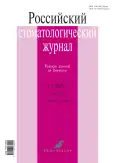Comparison of the effectiveness of Trioxident and Сanal Mineral Trioxide agregate for capping perforations in the pulp cavity
- Authors: Lipetskaya E.A.1, Furtsev T.V.2
-
Affiliations:
- Turukhansk area hospital
- V.F. Voino-Yasenetsky Krasnoyarsk State Medical University
- Issue: Vol 25, No 1 (2021)
- Pages: 35-41
- Section: Clinical Investigation
- URL: https://journals.rcsi.science/1728-2802/article/view/89229
- DOI: https://doi.org/10.17816/1728-2802-2021-25-1-35-41
- ID: 89229
Cite item
Abstract
BACKGROUND: The modern trend of dentistry is the principle of minimal invasiveness. Preservation of the vitality of the tooth is an actual principle of operation. In the treatment of deep caries or pulpitis by a biological method, the pulp chamber is often opened. Even with bleeding, there is a chance to leave the tooth vital. After hemostasis, antibacterial treatment of the carious cavity and padding were performed. Domestic manufacturers offer two analogues for these purposes — "Trioxident" and "Kanal MTA”.
AIM: The purpose of the study is to compare the effectiveness of domestic materials "Trioxident" and "Kanal MTA" when used as a therapeutic and insulating coating of pulp.
MATERIALS AND METHODS: 27 clinical cases were analyzed in patients aged 23–35 with a diagnosis of "deep dentine caries" K02.2 (according to ICD-10) of molars and premolars of the upper and lower jaws. All clinical cases combined patients' complaints of intermittent aching pains, the depth of carious cavities and the opened tooth cavity at one point. The patients were divided into two groups, in each of which the following stages of diagnosis and treatment were carried out. Diagnostics was carried out before the start of work and during examination after 7 days, 6, 12, 18 months. The stages of caries treatment were the same, only the materials for closing the perforations differed: in group 1 — "Trioxidant", in group 2 — "Kanal MTA".
RESULTS: It is noted that the use of materials "Trioxident" and "Kanal MTA" is an effective choice for closing perforations of the pulp chamber in the treatment of deep caries and chronic pulpitis. Pain was absent in 30.8% and 42.1% of patients in groups 1 and 2, respectively. After 6, 12, 18 months, patients did not complain about the treated teeth, the cold test was positive for a short time in 26 cases, the average current at electroodontodiagnostic (minimum value 4, maximum value 8) was 5.6 µA, 25 restorations had an Alpha rating according to Ryge criteria, in one case in group 1, the tooth crown darkened pointwise from the vestibular surface.
CONCLUSION: The materials "Trioxident" and "Kanal MTA" are recommended for use in the biological method of pulpitis treatment. They have therapeutic potential to cover the pulp and are competitive in relation to the foreign equivalent of "MTA Prorut", which gives them an economic advantage in providing dental care within the framework of compulsory medical insurance.
Full Text
##article.viewOnOriginalSite##About the authors
Ekaterina A. Lipetskaya
Turukhansk area hospital
Author for correspondence.
Email: ekaterinalipetsky@gmail.com
MD, Cand. Sci. (Med.)
Russian Federation, 663246, Bor, Turukhansk area, Krasnoyarsk regionTaras V. Furtsev
V.F. Voino-Yasenetsky Krasnoyarsk State Medical University
Email: taras.furtsev@gmail.com
ORCID iD: 0000-0002-5300-9274
MD, Dr. Sci. (Med.), Professor
Russian Federation, KrasnoyarskReferences
- Baginskii AL, Baginskii IV. Medical and social aspects of dental care of indigenous peoples. Journal of scientific articles "Health & education millenium". 2016;18(2):170–175. (In Russ).
- Salakhov AK, Sorokina AA, Ksembaev SS, Losev FF. Socio-hygienic aspects of the dental caries in adults and its prevention. Parodontologiya. 2020;(3):251–255. (In Russ). doi: 10.33925/1683-3759-2020-25-3-251-255
- Kovetskaya EE. Primenenija materiala na osnove trioksidagregata dlja lechenija pul'pita postojannyh zubov biologicheskim metodom. In: Sbornik tezisov respublikanskoj nauchno-prakticheskoj konferencii s mezhdunarodnym uchastiem, posvjashhennoj 20-letiju 2-j kafedry terapevticheskoj stomatologii UO "Belorusskij gosudarstvennyj medicinskij universitet" i jubileju professora Leusa Petra Andreevicha "Aktual'nye voprosy profilaktiki, diagnostiki i lechenija stomatologicheskih zabolevanij". Minsk; 2018. P:65–67. (In Russ).
- Hilton TJ. Keys to clinical success with pulp capping: a review of the literature. Oper Dent. 2009;34(5):615–625. doi: 10.2341/09-132-0
- Torskaya PA, Bazovaya MV, Shavyrina KI, et al. Klinicheskij sluchaj primenenija materiala "Trioksident" pri lechenii glubokogo kariesa. In: Sbornik tezisov Vserossijskoj nauchno-prakticheskoj konferencii s mezhdunarodnym uchastiem, posvjashhennoj 55-letiju kafedry terapevticheskoj stomatologii i 50-letiju kafedry ortopedicheskoj stomatologii Volgogradskogo gosudarstvennogo medicinskogo universiteta "Stomatologija — nauka i praktika. Perspektivy razvitija". Volgograd; 2020. P:172–173. (In Russ).
- Ruzina KA. Farmakojekonomicheskij analiz jeffektivnosti preparatov "Trioksident" i "Biodentin" pri lechenii glubokogo kariesa i prjamom pokrytii pul'py. Sbornik tezisov HHIII Mezhdunarodnoj mediko-biologicheskoj konferencii molodyh issledovatelej, posvjashhennaja 25-letiju medicinskogo fakul'teta SPbGU "Fundamental'naja nauka i klinicheskaja medicina — chelovek i zdorov'e". Saint Petersburg; 2020. P:255–256. (In Russ).
- Mitronin AV, Volgin MA, Kilbassa AM, et al. Comparative evaluation of the effectiveness of pulppreserving methods in the treatment of reversible pulpitis. Cathedra-Kafedra. Stomatologicheskoe obrazovanie. 2017;(60–61):30–35. (In Russ).
- Dammaschke T. The formation of reparative dentine and Höhl cells in the dental pulp. ENDO. 2010;(4):255–261.
- Kuzmina EA, Chuev VP. Trioksident — v pomoshh'' stomatologam. The dental institute. 2005;(3):112–113.
- Chizhevsky I, Stulikova V. Clinical examples of the drug "Trioksident" for treatment chronic pulpitis of deciduous teeth. Sovremennaya stomatologiya. 2014;(5):56. (In Russ).
- Manak TN, Borysenko TG, Reder AS. The choice of materials in the treatment of deep caries: a differentiated approach. Sovremennaya stomatologiya. 2020;(2):29–35. (In Russ).
Supplementary files









